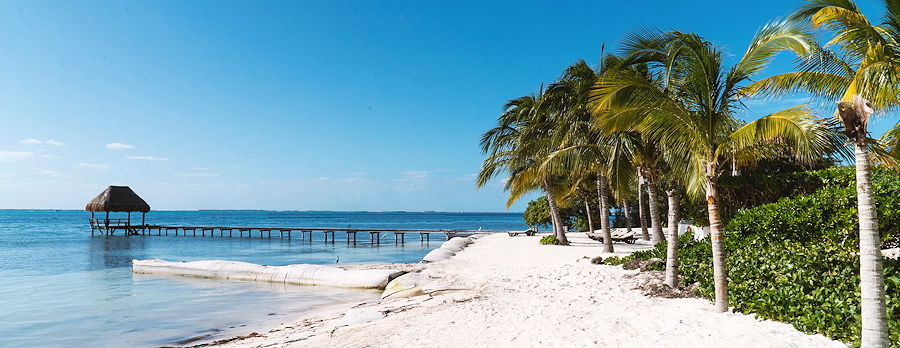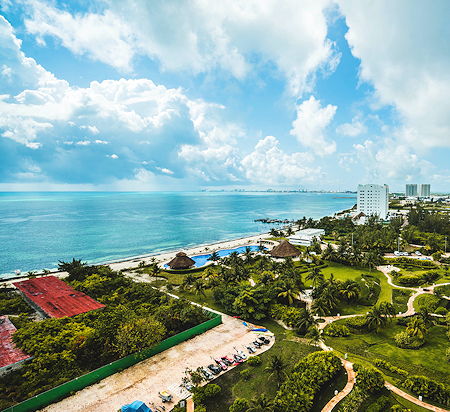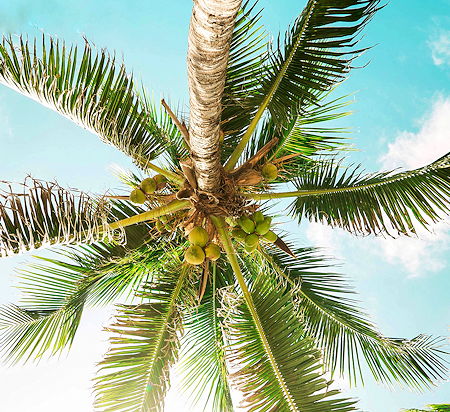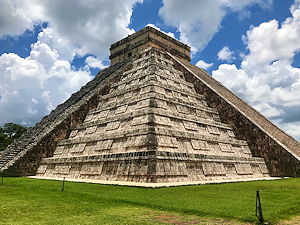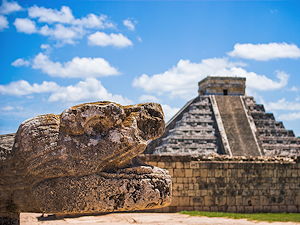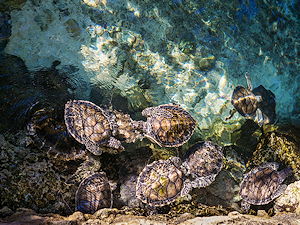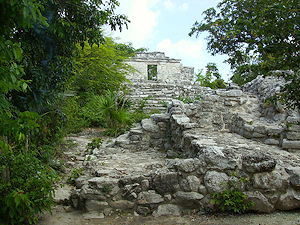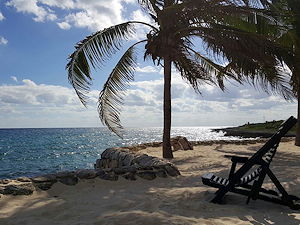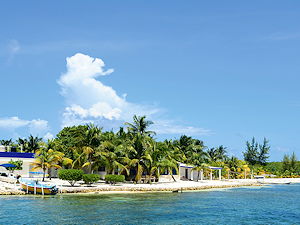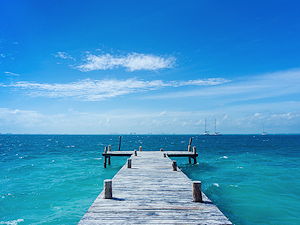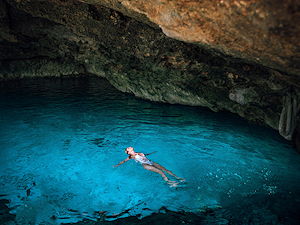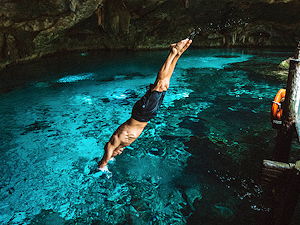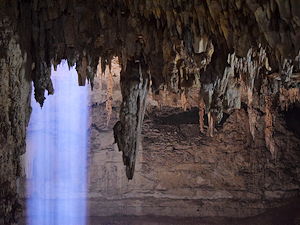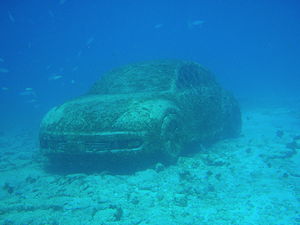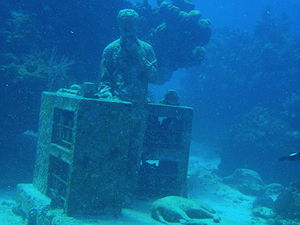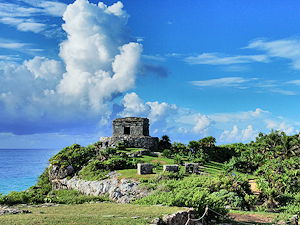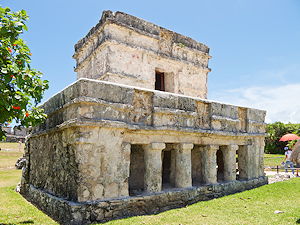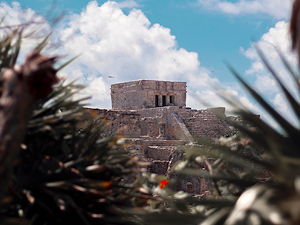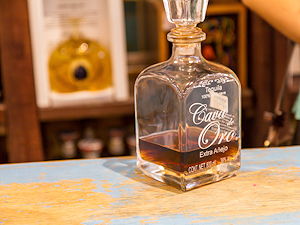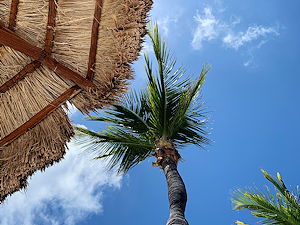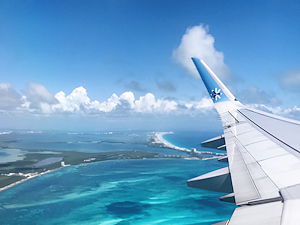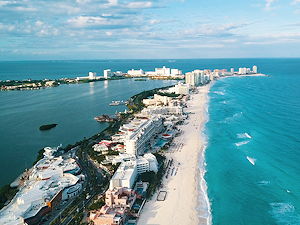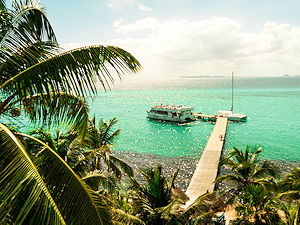Things to do in Cancún, Mexico
Cancun, found at the point where the Mexican Gulf meets the Caribbean Sea, is a paradise resort offering beaches, nightlife and natural beauty.
Don’t be put off by Cancun’s reputation as a go-to Spring Break destination, this place has plenty to offer travellers of all types. Beyond the Hotel Zone, there are opportunities for day trips to ancient Mayan ruins, lush jungles and eco-reserves.
1. Chichen Itza
An UNESCO World Heritage Site and the most impressive of Mexico’s Mayan ruins
The Mayan civilization, best known for its art, architecture, written language and astronomy, was powerful between about 2000 BC and 1500 AD, with Chichen Itza being built around 800 AD.
Consisting of four-square miles, the site is situated in the heart of the Yucatan Peninsula and is most famous for its central Kukulkan Pyramid (aka ‘El Castillo’) – a 78-foot high structure with four flights of 91 steps on each side leading to a central pedestal.
Other important parts of the site include the Sacrificial Cenote (a 90-foot deep sinkhole into which sacrifices were thrown), the Temple of the Warriors (with numerous 130-foot columns), the Observatory (known as El Caracol or ‘the Snail’ on account of its shape) and the Pelota Ball Court (the largest of Chichen Itza’s ball courts).
Where? Chichen Itza, 77500, Mexico Tel 52-987-2 09-72 Chichen Itza is a two to three-hour drive from Cancun
£$€¥ Site admission is 481 Pesos (It’s free for under 13’s and over 60’s)
2. Xcaret
Xcaret is a sprawling ecopark devoted to Mexico’s flora, fauna and culture
There is a lot to see and the ticket price is high – so make sure you arrive early and spend the whole day here. As for flora and fauna, Xcaret boasts a 37,000 square foot butterfly pavilion, an orchid house, a manatee lagoon, a deer shelter, a bat cave and island inhabited by monkeys and jaguars.
Traditional culture can be observed in a recreated and re-populated Mayan village, or by taking in the park’s ‘Spectacular Night’ – performed daily by 260 artists and showcasing Mexico’s past and present music, dance, costume and history.
Another significant draw are the water activities offered by the park. Visitors can swim or snorkel in lagoons, natural pools and underground rivers. Alternatively, they can try their hand at ‘Snuba’ diving.
Where? Xcaret Ecopark, Highway Chetumal-Puerto Juarez Km 282 Solidaridad, Quintana Roo, Mexico. Xcaret is 35 miles south of Cancun.
When? Xcaret opens every day of the year from 8.30 am – 9.00 pm in winter and 8.30 am – 10.00 pm in summer.
£$€¥ US $109.99 for adults and US $54.99 for children. To save money, book online at http://www.xcaret.com
3. Isla Mujeres
A sleepy Caribbean island where swinging in a hammock is as energetic as it gets
The Spanish meaning for Isla Mujeres is Island of women. Although it only takes fifteen minutes by ferry, this tiny chilled-out paradise is a world away from the hotel zone of Cancun. Only eight miles from the Yucatan peninsula, Isla Mujeres is 4.4 miles long by 2,130 feet wide and is easy to get around by bike, moped or golf cart.
Playa Norte on the north shore is a lovely white sand beach, lined by beachside bars and hammocks. The island is excellent for snorkelling and scuba diving and between the months of May and September it’s possible to swim with whale-sharks. Colourful sea wall murals were painted by a team of international artists to raise awareness of whale and shark conservation and eco-tourism.
The downtown area main strip is Avenida Hidalgo, where there are shops, bars and an abundance of fresh seafood restaurants. In the evenings, locals gather in the zocalo to enjoy live music and street food.
4. Swimming at Cenote
Take a refreshing underground dip in a mystical cenote
Formed when the roof of an underground cavern collapses, cenotes are water-filled limestone sinkholes. Yucatan is home to 7,000 cenotes and the fresh-water turquoise pools are wonderfully atmospheric places to take a dip and cool down from the heat of the Yucatan sun. A massive underground network connects the sinkholes to one another.
Reminiscent of the movie ‘Journey to the Centre of the Earth’, swimming in cenotes is a unique experience. Small fish swim around your feet and bats often fly overhead. The Mayans believed that cenotes were a portal to the underworld and were used for sacrificial purposes.
The nearest cenotes to Cancun are Boca del Puma which is in Boca del Puma Eco Park and Cenote Verde Lucero in Selvatica Eco Park near Puerto Moreles.
A few of the more remote cenotes are little visited Cenote Sieta Bocas, Azul and Dos Ojos. Ruta de los Cenotes, which is a near Puerte Morelos provides an opportunity to visit several cenotes on one day. It’s best to take a tour as most of the cenotes are situated off the highway are only accessible via bumpy dirt roads.
Where? Can be found throughout Yucatan and vary from remote and peaceful jungle locations to cenotes with shops, changing rooms and other facilities.
When? Opening hours vary, but they are generally open between about 8.00 am – 6.00 pm
£$€¥ $5.00 - $20.00
5. Cancun Underwater Museum
An otherworldly museum under the sea which helps to conserve coral reefs
This underwater museum is situated just of the coast of Cancun and comprises of over five hundred statues and sculptures. Run by a non-profit organisation dedicated to conservation, it’s a spectacular sight and can be seen on scuba diving, snorkelling and glass-bottom boat tours.
Most of the sculptures are created by British sculptor, Jason de Caires Taylor while five Mexican sculptors are responsible for the others. The sculptures are made from materials that promote coral life and the motivation behind the project is to save nearby coral reefs by providing an alternative destination for divers.
Sculptures include human figures of all ages, shapes and sizes, a ubiquitous Mexican VW bug and a small house and are spread out through three galleries. Eerie, yet beautiful – it’s certainly a museum with a difference.
When? The museum is open from 9.00 am – 5.00 pm daily
Where? Off the coast of Cancun
£$€¥ Tours start at around $45.00 and go up to approximately $160.00 depending on the length and type of tour
6. The ancient temple ruins of Tulum
A stunning ancient temple perched on rugged cliffs above the Caribbean Sea
A day trip away, the ancient ruins of Tulum are eighty miles south of Cancun. The walled Mayan city is situated on a cliff top overlooking the sparkling turquoise waters of the Caribbean - the Mayans certainly knew what they were doing when they chose this location to settle in.
Although there is evidence that people resided in the area as long ago as the 6th century, Tulum was built in the late 13th century as a seaport. El Castillo is the main pyramid and most photographed of the buildings, serving as a lighthouse back in the day. After exploring the ruins, visitors can swim in the sea below El Castillo in the precise spot that canoes came ashore in ancient times.
This part of the coast was a natural meeting point for traders who arrived via both land and sea. Food, metals and cotton were the main commodities and Tulum was very much a hub for merchants. At its height, Tulum was home to approximately 1,600 inhabitants.
When? The Tulum ruins are open from 8.00 am – 5.00 pm and last entrance is at 4.30 pm. It is advisable to get there as early as possible – at around 11.00 am the tour buses arrive and the ruins become extremely crowded.
Where? Carretera Federal, Cancun-Chetumal Km 230, 307, Tulum 77780. Tulum is situated is approximately a two-hour drive south of Cancun. It’s possible to take a bus to the town of Tulum and then a taxi to the ruins or hire a car, but the most popular way to experience the ruins from Cancun is on a tour.
£$€¥ Entrance is 70 pesos. For those who are interested in learning more about the ruins, official guides can be hired at the entrance for 500-600 pesos.
7. Nightlife of Cancun
Mexico’s premier party destination
Cancun is known for its vibrant nightlife and is the primary reason that many people choose to visit the glitzy metropolis.
It’s a popular spring break spot for American students to let off steam and there’s no end of venues for those who want to dance into the wee small hours. Most clubs don’t even get started until around midnight, but there are an abundance of pre-club bars to kick the evening off. Some bars are open 24/7, but many open at lunchtime and stay open until the following morning.
Coco Bongo is the most famous of Cancun’s clubs and plays host to spectacular acrobatic displays, live bands and dancers. DJ’s take over around midnight and revellers take to the floor.
A few of the hotels have their own club on the premises and provide ‘party packages’ and many bars sell ‘open bar’ bracelets allowing customers to drink all night. There are theme nights galore and a vibrant live music scene.
It can get a little wild and crazy, but with endless options, there’s nowhere in the world quite like Cancun if you want to party.
8. More things to do in Cancun
Museo Maya de Cancun
Learn about Mayan culture in the heart of the Hotel Zone. Amongst the hotels, bars and restaurants of the Hotel Zone, Museo Maya de Cancun offers a slice of culture in a city which is otherwise dedicated to the pursuit of decadence.
Opened in 2012, after the original anthropology museum was damaged by a hurricane, it houses one of the most important collection of Mayan artefacts in Yucatan.
The museum itself is contemporary and light, a white building with large windows and designed by Mexican architect Alberto Garcia Lascurain. Although it has about 3,000 artefacts in its collection, it has approximately 400 pieces on display at any one time. Most of the exhibits have been found at sites throughout Yucatan and include jewellery ceramics and sculptures.
There are three galleries, two are for permanent exhibits, the first dedicated to the archaeology of the state of Quintana Roo and second to Mayan culture from further afield. The third gallery is for temporary exhibitions.
Behind the museum, the archaeological site of San Miguelito is set amongst lush jungle and is an unexpected delight. There is also a café on the ground floor.
When? Tuesday – Sunday 9.00 am – 6.00 pm (last entry 5.30 pm).
Where? Quintana Roo Blvd, Kukulcan Km 16.5 Esq. Gucumatz, Cancun 77504.
£$€¥ 75 pesos per adult and free for under 13’s and over 60’s.
Sian Ka’an Biosphere Reserve
A diverse and beautiful landscape with bountiful wildlife. Mayan for where the sky is born, Sian Ka’an is a 1.3 miliion acre reserve and an area of great natural beauty. Jungle, coral reefs, beaches, lagoons and cenotes are all part of the eco-system making up this reserve which was established in 1986.
Named as an UNESCO World Heritage Site in 1987, it is even home to a stunning barrier reef. With 23 pre-Hispanic archaeological sites and Mayan-constructed canals, which were used to transport goods, there are both natural and man-made wonders to appreciate.
The reserve is home to its fair share of wildlife too. Dolphins, manatees, crocodiles and endangered turtles are easily spotted, as are howler monkeys. It takes a little more luck to spot a puma or jaguar though. Bird-lovers will be in heaven as the area is home to 350 species of bird life.
There are plenty of opportunities for swimming and snorkelling in the crystal-clear waters and taking a tour here is a highlight of a trip to Yucatan and a chance to experience the richest eco-system in Mexico
Where? About three hours south of Cancun by road.
£$€¥ Tours start at approximately $130.00.
The Contoy Island
A peaceful paradise where birds outnumber humans. This small island is protected by the government and located about 23 miles away from the madness of Cancun and an hour and a half by boat. Contoy Island is 5.3 miles long and uninhabited except for a research centre dedicated to protecting sea birds and turtles. The island is a bird sanctuary where 80 species co-exist, the most common being the brown pelicans and frigates.
Only 200 people a day are allowed on the island in order to preserve the balance of humans and nature. With its secluded white beaches and swaying palm trees, it’s as close to paradise as it’s possible to get. There is a watchtower for viewing the birdlife, a visitor centre, museum and souvenir store. Tours usually include a snorkelling excursion and many of them take in Isla Mujeres as well.
£$€¥ Tours start at approximately $130.00
The famous Cancun Beaches
A Beach-life in Yucatan’s metropolis. With around 14 miles of soft white sand beaches along Cancun’s coastline, there’s no shortage to choose from and each of them have their own unique vibe. Here are a few of the best:
Playa Delfines is a large public beach where the locals tend to hang out. There are food and drink vendors aplenty, but it’s absent of nearby restaurants or hotels. This beach is where the famous Cancun sign is located – a popular photograph opportunity, although you may have to wait in line to take your turn. It’s a great place to sit and watch the waves crashing in, but not suitable for swimming due to a strong current.
Playa Choc Mool in the Hotel Zone is a busy beach with lots of nearby snack bars and restaurants. It’s ideal for surfing and other water-sports and is safe for swimming if the conditions are right. On the north side, there’s a rocky outcrop and rock pool to explore.
Families often head for Playa Tortugas where the beach is narrow and and the water is shallow. It’s an ideal spot for children to splash around and have fun. The beach has a marina, restaurant and there is a bungy tower for extreme sports enthusiasts. The ferry to Isla Mujeres leaves from this beach.
Playa Carocol is in the heart of the Hotel Zone and is a small beach located between two docks. The water can get a little choppy making it perfect for bodyboarders, but also suitable for strong swimmers. There are loungers and umbrellas to rent and it’s close to restaurants and a large supermarket where you can pick up your beach supplies.
